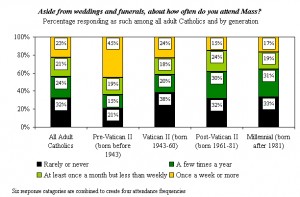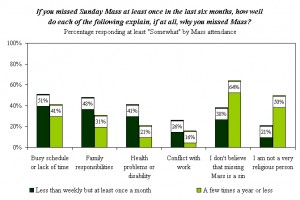The following article appeared in the New York Times earlier this week. Written by Laurie Goodstein, it reports on a CARA study showing a strong preference for and return to tradition among young adults who enter priesthood and religious life. I have known this anecdotally for years but now we have some hard data to chew on. Here I publish excerpts of the NY Times article and put my own commentary in red. Note: you can click on the graph to the lower left to see a clearer image of the graph.
A new study of Roman Catholic nuns and priests in the United States shows that an aging, predominantly white generation is being succeeded by a smaller group of more racially and ethnically diverse recruits who are attracted to the religious orders that practice traditional prayer rituals and wear habits. [In recent years I have personally experienced a lot of ethnic diversity in vocations gatherings. Through a movement known as the Neocatechumenal Way we have we havemen from all over the world studying for the priesthood here in DC. At my own parish there are over 25 Religious sisters in our Convent from the Servant Sisters of the Lord (see photo above right of Sisters, novices and postulants) and they too include some Americans but when I am with them I feel like I’m at the U.N. The Church really is “catholic” (universal) after all].
 The study found that the graying of American nuns and priests was even more pronounced than many Catholics had realized. Ninety-one percent of nuns and 75 percent of priests are 60 or older, and most of the rest are at least 50. They are the generation defined by the Second Vatican Council, of the 1960s, which modernized the church and many of its religious orders. Many nuns gave up their habits, moved out of convents, earned higher educational degrees and went to work in the professions and in community service. [Well, the article simplifies things a bit. Just because you are old and white doesn’t necessarily mean that you are one of the “modernizers.” To be sure that generation collectively did the things described here but not every member of that generation went as far as moving out of convents, gave up habits etc. It’s about more than age and race].
The study found that the graying of American nuns and priests was even more pronounced than many Catholics had realized. Ninety-one percent of nuns and 75 percent of priests are 60 or older, and most of the rest are at least 50. They are the generation defined by the Second Vatican Council, of the 1960s, which modernized the church and many of its religious orders. Many nuns gave up their habits, moved out of convents, earned higher educational degrees and went to work in the professions and in community service. [Well, the article simplifies things a bit. Just because you are old and white doesn’t necessarily mean that you are one of the “modernizers.” To be sure that generation collectively did the things described here but not every member of that generation went as far as moving out of convents, gave up habits etc. It’s about more than age and race].“We’ve heard anecdotally that the youngest people coming to religious life are distinctive, and they really are,” said Sister Mary Bendyna, [I have met with a worked with Sr. Bendyna. She is very thorough and very honest in interpreting data. I have a great deal of respect for her work and her insistence on acknowledging what the data says, distinct from what ideologies might wish the data says.]executive director of the Center for Applied Research in the Apostolate. “They’re more attracted to a traditional style of religious life, where there is community living, common prayer, having Mass together, praying the Liturgy of the Hours together. They are much more likely to say fidelity to the Church is important to them. And they really are looking for communities where members wear habits.” [I have often wondered by many more “modernized” orders that resist accepting this fact continue down the road which does not have many of these features described Sister. They observe the orders with more traditional features getting numerous vocations while their own orders do not. There is a very strange resistance at work here. Ultimately it seems non-existence is in the future of some of the orders that refuse to adapt. But that doesn’t seem to phase them. I remember talking to several Benedictine Sisters at a recent workshop. Their branch of the Benedictines has become very modernized and hasn’t had a vocation in years. When I asked them why they hadn’t consider changing their approach, they gave me a rather surprising answer. They indicated that maybe it was time for Religious Life to largely go away and to hand the Church back to it’s “rightful owners,” the laity. Wow! They seemed to have lost any notion of the Charism of Religious Life. Great to know the laity are more involved today but religious life is surely still and important gift of the Lord to the Church, seems to me!. Now this was just one group of sisters. I haveno idea how representative their answer is of other communities that seem to be unable or unwilling to adapt]. Of the new priests and nuns who recently joined religious orders, two-thirds chose orders that wear a habit all the time or regularly during prayer or ministry, the study found.
The study also showed that whites account for 94 percent of current nuns and priests but only 58 percent of those in the process of joining orders. Asians and Pacific Islanders are disproportionately represented among the newcomers, accounting for 14 percent, far above their 3 percent share of the Catholic population in the United States, Sister Bendyna said. Hispanics are 21 percent of the newcomers, compared with only 3 percent of the current priests and nuns.
Of women who recently entered religious orders, the average age is 32; for men, it is 30. But retaining new recruits is a challenge. About half of those who have entered religious orders since 1990 have not stayed, and almost all who left did so before making their final vows. [This doesn’t really mean that they “left.” It is like a seminarian going off to seminary. One of the purposes of that time is further discernment, “Is this what God is calling me to do?” A seminarian who chooses to leave the seminary is not said to have “left the priesthood.” So also those who leave before final vows are not said to have left religious life]. “People come to religious life because they feel they’re being called,” said Brother Paul Bednarczyk, executive director of the National Religious Vocation Conference, adding that the purpose of the Church’s training process “is to discern that call before a commitment is made.” So “it’s not surprising,” he said, “that you would have people that would leave.”
My favorite vocations video:






